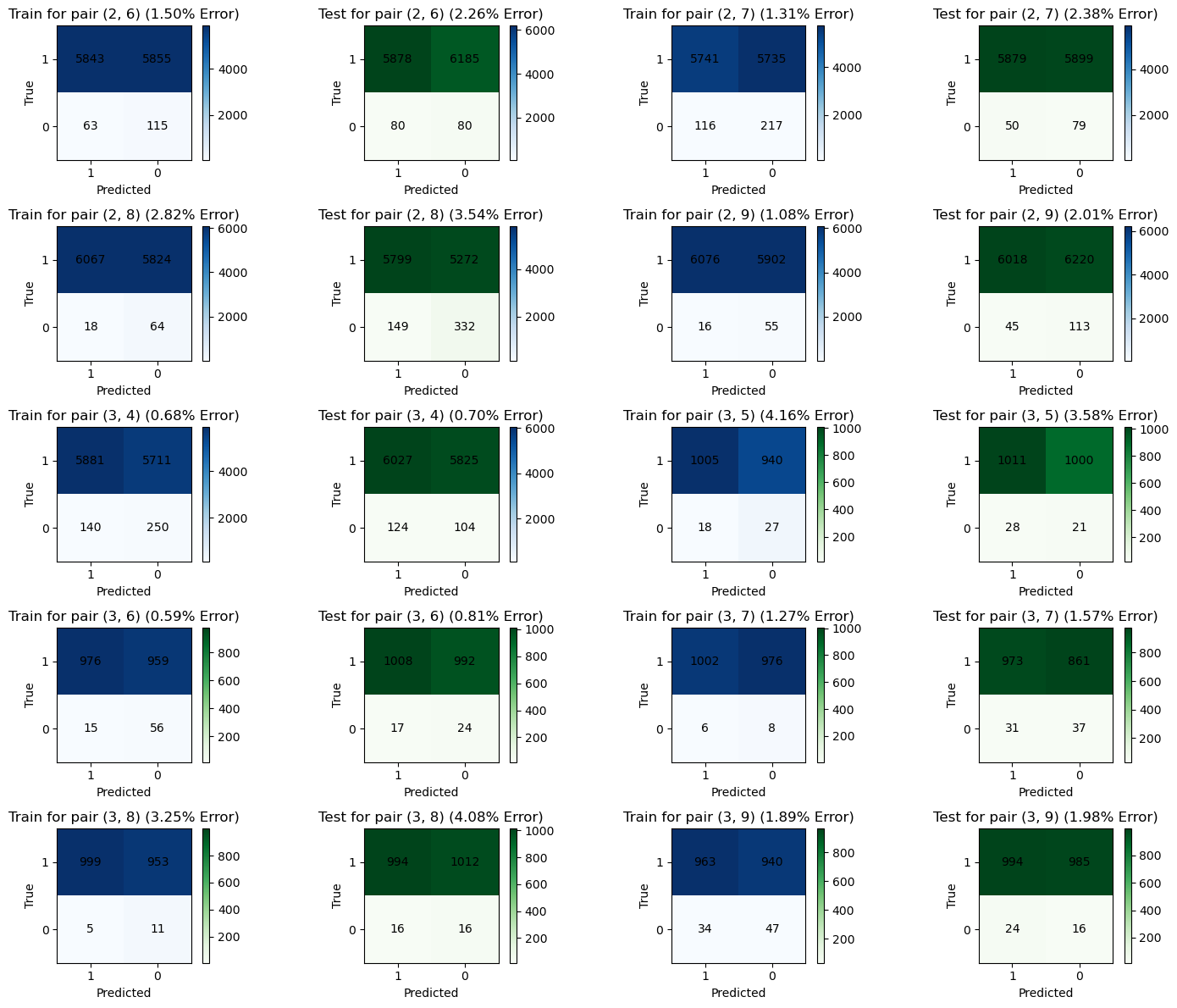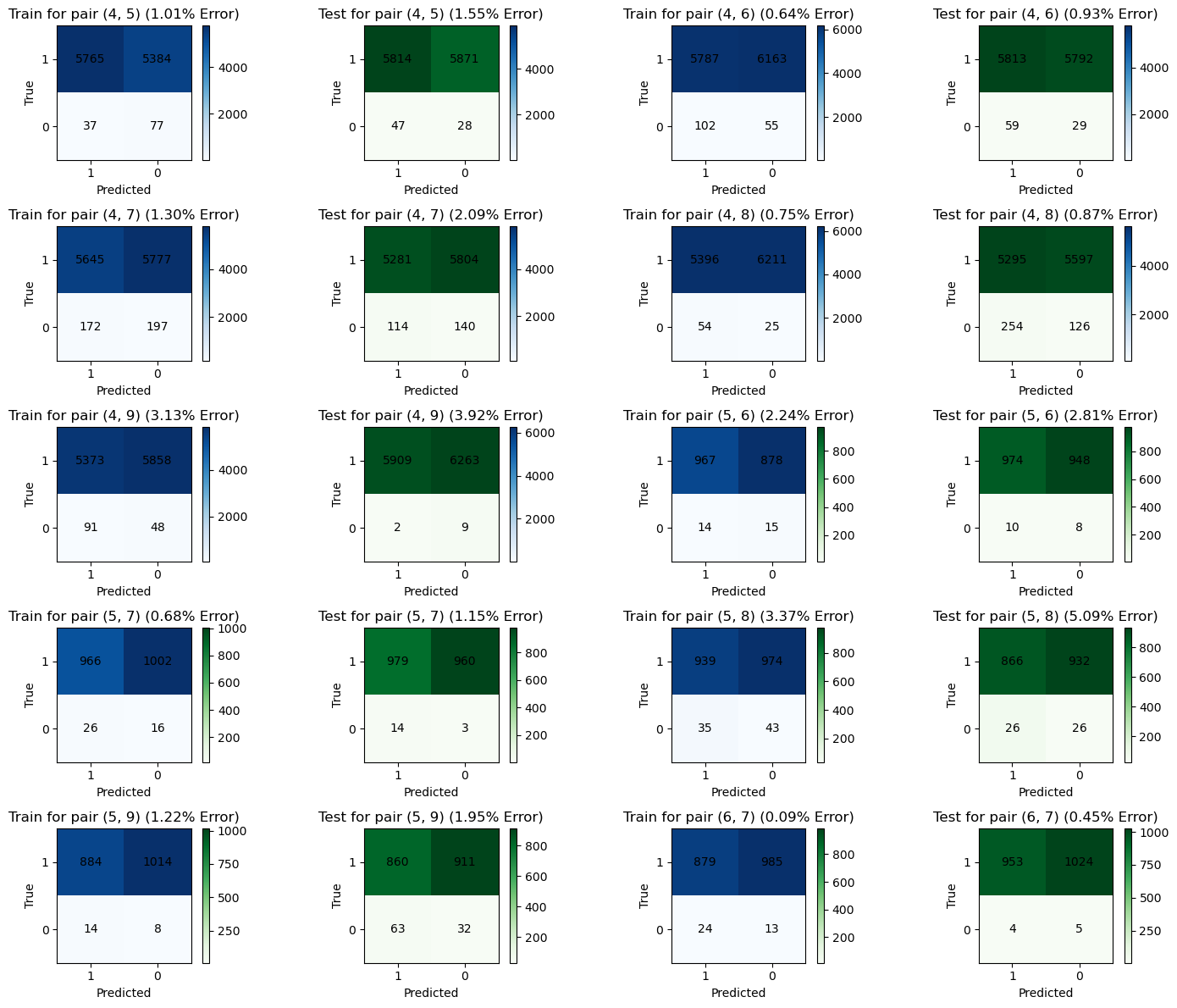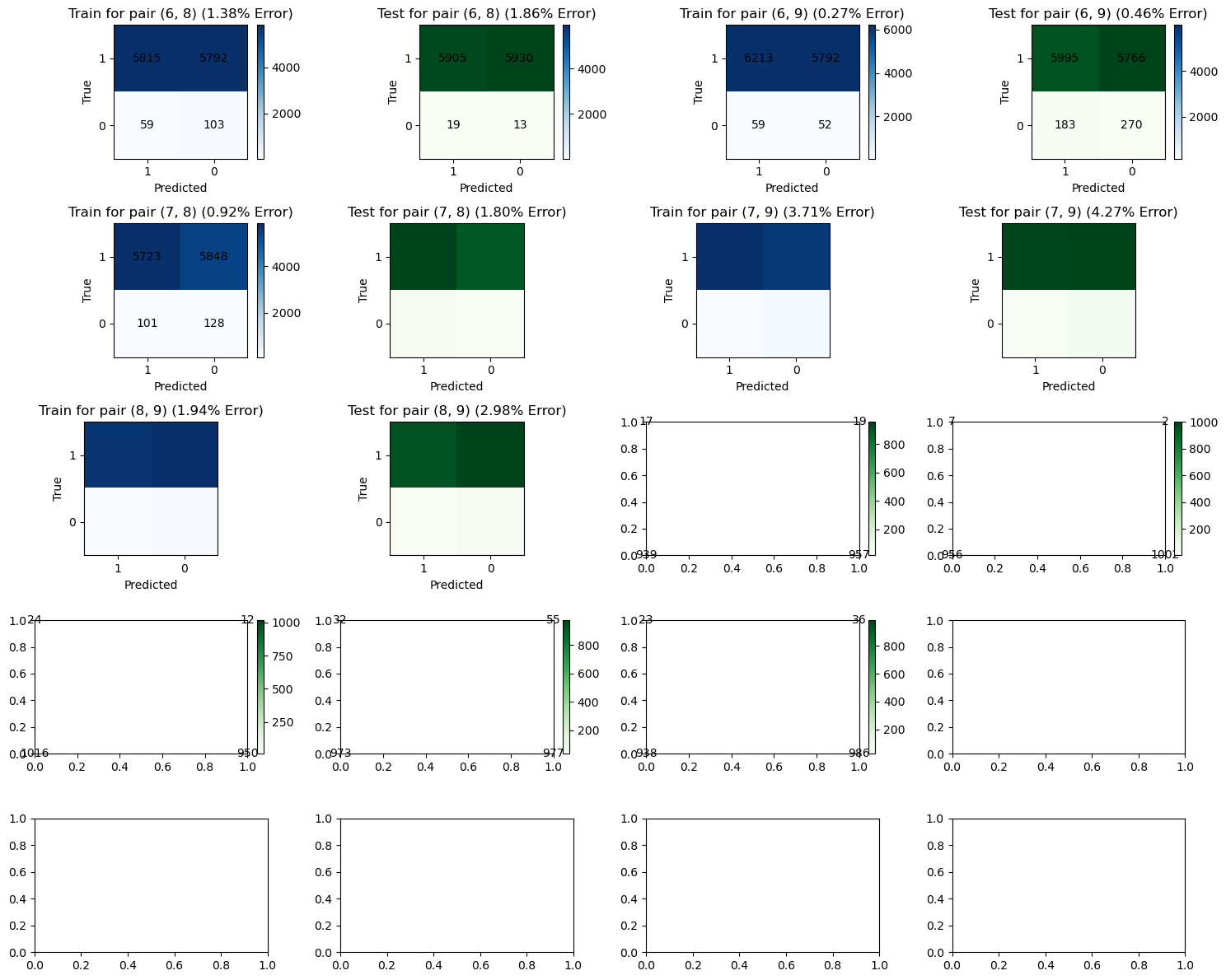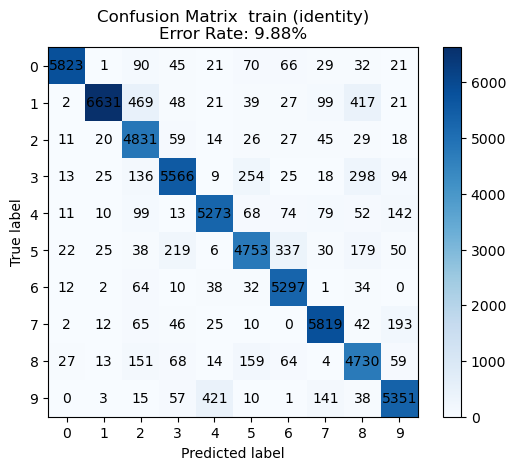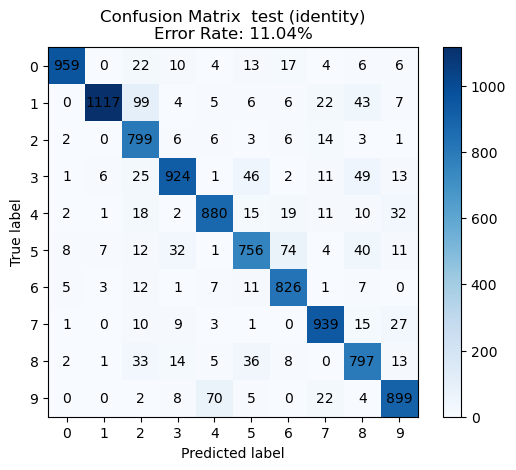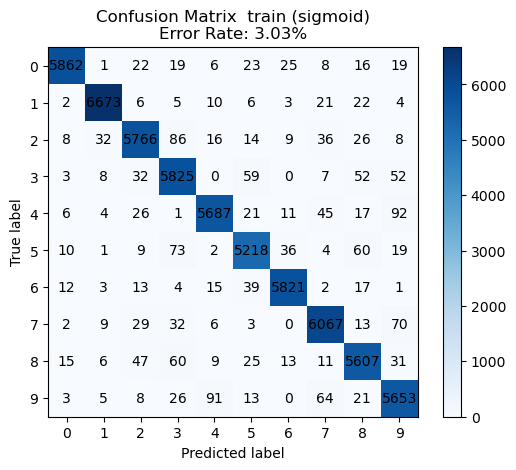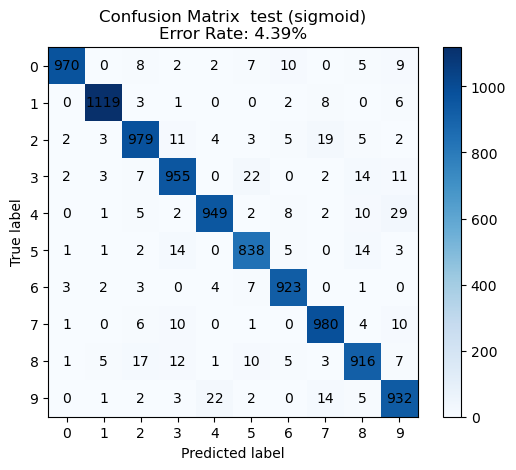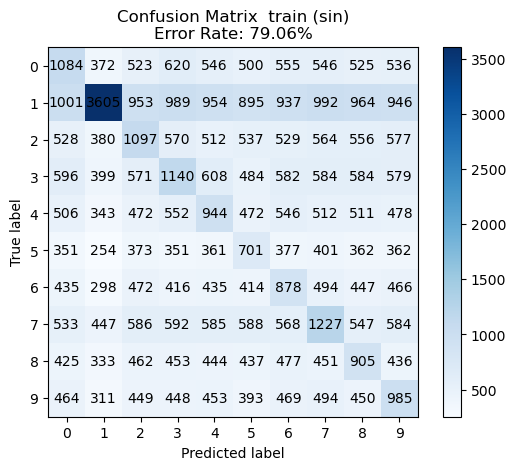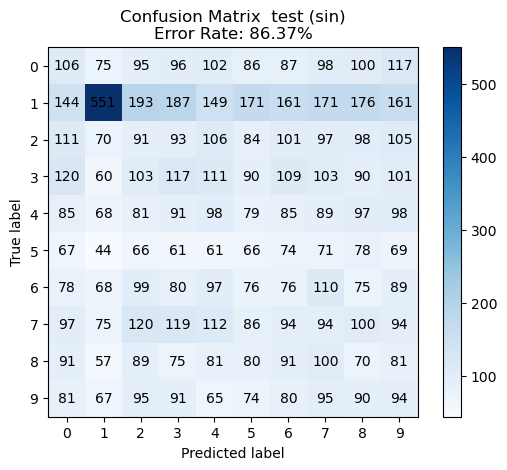Welcome! This was a project for ECE 174 at UCSD with Professor Piya Pal. All the code is
in project.ipynb.
We essentially create a classifier for handwritten digits using nothing but linear algebra (i.e. no gradient descent). Then, we try to get better performance by engineering new features that are nonlinear maps from the dataset. Finally, we see how much we can improve performance by expanding the feature size.
import scipy
import numpy as np
from tqdm.notebook import tqdm
from numba import njit
def np_array(shape):
return np.array(shape, dtype=np.float32)
def np_zeros(shape):
return np.zeros(shape, dtype=np.float32)
def np_ones(shape):
return np.ones(shape, dtype=np.float32)data = scipy.io.loadmat('mnist.mat')testX, testY, trainX, trainY = data['testX'], data['testY'], data['trainX'], data['trainY']
# Normalize data
testX = (testX / 255.0).astype(np.float32)
trainX = (trainX / 255.0).astype(np.float32)
trainY = (trainY.T).astype(np.float32)
testY = (testY.T).astype(np.float32)print(f"{testX.shape=}")
print(f"{testY.shape=}")
print(f"{trainX.shape=}")
print(f"{trainY.shape=}")testX.shape=(10000, 784)
testY.shape=(10000, 1)
trainX.shape=(60000, 784)
trainY.shape=(60000, 1)
%matplotlib inline
from matplotlib import pyplot as plt
def display_image(normalized_data):
# data should contain values in [0,1]
scaled = normalized_data.reshape((28,-1)) * 255
plt.imshow(scaled, interpolation='nearest')
plt.show()i = 20
display_image(trainX[i]), trainY[i](None, array([4.], dtype=float32))
We want to solve the problem
where
From the work shown in class, we show that the following must be true for a least squares solution
where
Then, we can solve for
First, we want to compare class
# Add column of ones for bias
def create_one_v_all_classifier(trainX, trainY, n):
A = np.column_stack((trainX, np_ones(trainX.shape[0]))).astype(np.float32)
y = np.copy(trainY)
mask1, mask2 = trainY == n, trainY != n
y[mask1] = 1.0
y[mask2] = -1.0
return A, yNow we use the pseudoinverse function, which solves least-squares.
@njit
def solve_one_v_all_classifier(A, y):
A = A.astype(np.float32)
y = y.astype(np.float32)
B = np.linalg.pinv(A) @ y
return B.astype(np.float32)And let's make some functions that compute and display the confusion matrices of the model.
@njit
def binary_confusion_matrix(A, y, x):
m = np.zeros((2,2))
pred = np.sign(A @ x)
tp = np.sum((pred == 1) & (y == 1))
tn = np.sum((pred == -1) & (y == -1))
fp = np.sum((pred == 1) & (y == -1))
fn = np.sum((pred == -1) & (y == 1))
return np.array([
[tp, tn],
[fp, fn]
])
@njit
def evaluate(X_test, y_test, x, n):
m = binary_confusion_matrix(X_test, y_test, x)
display_binary_confusion_matrix(m, n)
@njit
def display_binary_confusion_matrix(conf_matrix, n, ax):
error_rate = conf_matrix[1, :].sum() / conf_matrix.sum()
# fig, ax2 = plt.subplots(figsize=(8, 8))
cax = ax.matshow(conf_matrix, cmap='Blues')
# Add colorbar
fig.colorbar(cax)
# Set labels for the x and y axes
ax.xlabel('Predicted')
ax.ylabel('True')
# Add a title with the error rate
ax.title(f'Confusion Matrix for digit {n}\nError Rate: {error_rate:.2%}')
# Display the values inside the matrix
for i in range(conf_matrix.shape[0]):
for j in range(conf_matrix.shape[1]):
plt.text(j, i, f'{int(conf_matrix[i, j])}', ha='center', va='center', color='black')
plt.show()Now let's see what the results are for each class
m_trains, m_tests = [], []
one_v_all_models = []
for n in tqdm(range(10)):
A, y = create_one_v_all_classifier(trainX, trainY, n)
x = solve_one_v_all_classifier(A, y)
one_v_all_models.append(x) # save for later use
m_train = binary_confusion_matrix(A, y, x)
m_trains.append(m_train)
A_test, y_test = create_one_v_all_classifier(testX, testY, n)
m_test = binary_confusion_matrix(A_test, y_test, x)
m_tests.append(m_test)
one_v_all_models = np.array(one_v_all_models).reshape((10, -1)) 0%| | 0/10 [00:00<?, ?it/s]
# source: ChatGPT
# Create a figure with 4 rows and 5 columns of subplots
def create_binary_confusion_matrix_plot(m_trains, m_tests, start=0):
fig, axs = plt.subplots(5, 4, figsize=(15, 12))
# Flatten the axs array to make it easier to iterate
axs_flat = axs.flatten()
# Iterate through the confusion matrices and plot them
for i, (m_train, m_test) in enumerate(zip(m_trains, m_tests)):
# Plot the confusion matrix for training data
im = axs_flat[2*i].imshow(m_train, cmap='Blues', interpolation='nearest')
# Add numbers to each square
for x in range(2):
for y in range(2):
axs_flat[i].text(y, x, str(m_train[x, y]), color="black", ha="center", va="center")
# Add labels, title, and colorbar
axs_flat[2*i].set_title(f'Train for digit {i} ({100*m_train[1,:].sum()/m_train.sum():.2f}% Error)')
axs_flat[2*i].set_xticks(np.arange(2))
axs_flat[2*i].set_yticks(np.arange(2))
axs_flat[2*i].set_xticklabels(['0', '1'])
axs_flat[2*i].set_yticklabels(['0', '1'])
axs_flat[2*i].set_xlabel('Predicted')
axs_flat[2*i].set_ylabel('True')
plt.colorbar(im, ax=axs_flat[i], fraction=0.046, pad=0.04)
# Plot the confusion matrix for testing data
im = axs_flat[2*i+1].imshow(m_test, cmap='Greens', interpolation='nearest')
# Add numbers to each square
for x in range(2):
for y in range(2):
axs_flat[i + 10].text(y, x, str(m_test[x, y]), color="black", ha="center", va="center")
# Add labels, title, and colorbar
axs_flat[2*i+1].set_title(f'Test for digit {i} ({100*m_test[1,:].sum()/m_test.sum():.2f}% Error)')
axs_flat[2*i+1].set_xticks(np.arange(2))
axs_flat[2*i+1].set_yticks(np.arange(2))
axs_flat[2*i+1].set_xticklabels(['0', '1'])
axs_flat[2*i+1].set_yticklabels(['0', '1'])
axs_flat[2*i+1].set_xlabel('Predicted')
axs_flat[2*i+1].set_ylabel('True')
plt.colorbar(im, ax=axs_flat[i + 10], fraction=0.046, pad=0.04)
# Adjust layout for better spacing
plt.tight_layout()
plt.show()
create_binary_confusion_matrix_plot(m_trains, m_tests)From the data, we see that digits 9, 8, 5, and 2 are the hardest to recognize.
Using the one-v-all classifier, we can build a multiclass classifier given by
@njit
def multiclass_predict(models, x) -> int:
preds = models @ x
return int(np.argmax(preds))conf_matrix_ova = np_zeros((10, 10))
testX_ones = np.c_[testX, np.ones(testX.shape[0])].astype(np.float32)
n = 0
for row, actual in zip(testX_ones, testY):
pred = multiclass_predict(one_v_all_models, row)
actual = int(actual)
conf_matrix_ova[actual][pred] += 1/var/folders/qs/qtpxyfmd5bv20vyzlfl11ncc0000gn/T/ipykernel_3616/274643382.py:3: NumbaPerformanceWarning: �[1m�[1m'@' is faster on contiguous arrays, called on (Array(float32, 2, 'C', False, aligned=True), Array(float32, 1, 'A', False, aligned=True))�[0m�[0m
preds = models @ x
def plot_multiclass_confusion_matrix(confusion_matrix, title=''):
"""
Plot a multiclass confusion matrix with row and column totals.
Parameters:
- confusion_matrix: numpy array, the confusion matrix to be plotted
Returns:
None
"""
# Calculate row and column totals
row_totals = np.sum(confusion_matrix, axis=1)
col_totals = np.sum(confusion_matrix, axis=0)
# Calculate the error rate
total_samples = np.sum(confusion_matrix)
correct_predictions = np.trace(confusion_matrix)
error_rate = 1 - (correct_predictions / total_samples)
# Create a figure and axes
fig, ax = plt.subplots()
# Plot the confusion matrix using imshow
cax = ax.imshow(confusion_matrix, cmap='Blues', interpolation='nearest')
# Add text annotations for each element in the matrix
for i in range(confusion_matrix.shape[0]):
for j in range(confusion_matrix.shape[1]):
ax.text(j, i, int(confusion_matrix[i, j]), va='center', ha='center')
# Set labels for rows and columns
ax.set_xticks(np.arange(confusion_matrix.shape[1]))
ax.set_yticks(np.arange(confusion_matrix.shape[0]))
ax.set_xticklabels(np.arange(confusion_matrix.shape[1]))
ax.set_yticklabels(np.arange(confusion_matrix.shape[0]))
# Set labels and title
plt.xlabel('Predicted label')
plt.ylabel('True label')
plt.title(f'Confusion Matrix {title}\nError Rate: {error_rate:.2%}')
# Add colorbar
plt.colorbar(cax)
# Display the plot
plt.show()plot_multiclass_confusion_matrix(conf_matrix_ova)Now let's create a multiclass classifier built out of 1v1 classifiers. These will compare classes
To do this, we need to filter out only the data that belongs to classes
def create_1v1_classifier(X, y, i, j):
# Return matrix A such that only digits with labels with i or j are included
# Return matrix y such that only labels with i or j are included
mask = (y == i) | (y == j)
big_mask = np.tile(mask, (1, X.shape[1]))
A = X[big_mask].reshape((-1, X.shape[1]))
A = np.column_stack((A, np.ones(A.shape[0]))) # add ones
# Select only relevant labels
_y = y[mask]
# Re-label
i_mask = _y == i
j_mask = _y == j
_y[i_mask] = 1
_y[j_mask] = -1
assert _y.shape[0] == A.shape[0] # should have same number of rows
return A.astype(np.float32), _y.astype(np.float32)The solution and prediction will be exactly the same.
@njit
def solve_1v1_classifier(A, y):
B = np.dot(np.linalg.pinv(A), y)
return B.astype(np.float32)
@njit
def predict_1v1(x, dig):
return np.sign(dig @ x, dtype=np.int8)Now that we can create a classifier for any pair
import itertools
import functools
# All pairs of numbers under 10
pairs = list(itertools.combinations(range(10), 2))
def create_1v1_confusion_matrix(X, y, i, j, x):
A, _y = create_1v1_classifier(X, y, i, j)
return binary_confusion_matrix(A, _y, x)def solve_multiclass_classifier(pairs, trainX, trainY):
gs = [] # list of (i, j, solution)
for i, j in tqdm(pairs):
# Parse data for (i, j)
A, y = create_1v1_classifier(trainX, trainY, i, j)
# Solve
x = solve_1v1_classifier(A, y)
gs.append((i, j, x))
return gs
def compute_1v1_confusion_matrices(gs, test_x, test_y):
# compute confusion matrices for each pair
return [(i, j, create_1v1_confusion_matrix(test_x, test_y, i, j, x)) for i, j, x in gs]gs = solve_multiclass_classifier(pairs, trainX, trainY) 0%| | 0/45 [00:00<?, ?it/s]
m_train_1v1 = compute_1v1_confusion_matrices(gs, trainX, trainY)
m_test_1v1 = compute_1v1_confusion_matrices(gs, testX, testY)def grouper(iterable, n, *, incomplete='fill', fillvalue=None):
"Collect data into non-overlapping fixed-length chunks or blocks"
# grouper('ABCDEFG', 3, fillvalue='x') --> ABC DEF Gxx
# grouper('ABCDEFG', 3, incomplete='strict') --> ABC DEF ValueError
# grouper('ABCDEFG', 3, incomplete='ignore') --> ABC DEF
args = [iter(iterable)] * n
if incomplete == 'fill':
return itertools.zip_longest(*args, fillvalue=fillvalue)
if incomplete == 'strict':
return zip(*args, strict=True)
if incomplete == 'ignore':
return zip(*args)
else:
raise ValueError('Expected fill, strict, or ignore')
def create_binary_confusion_matrix_plot(m_trains, m_tests):
pairs = [(i, j) for i, j, x in m_trains]
m_trains = [x for _, _, x in m_trains]
m_tests = [x for _, _, x in m_tests]
assert len(m_trains) == len(m_tests)
fig, axs = plt.subplots(5, 4, figsize=(15, 12))
# Flatten the axs array to make it easier to iterate
axs_flat = axs.flatten()
# Iterate through the confusion matrices and plot them
for i, (m_train, m_test) in enumerate(zip(m_trains, m_tests)):
j, k = pairs[i]
# Plot the confusion matrix for training data
im = axs_flat[2*i].imshow(m_train, cmap='Blues', interpolation='nearest')
# Add numbers to each square
for x in range(2):
for y in range(2):
axs_flat[i].text(y, x, str(m_train[x, y]), color="black", ha="center", va="center")
# Add labels, title, and colorbar
axs_flat[2*i].set_title(f'Train for pair ({j}, {k}) ({100*m_train[1,:].sum()/m_train.sum():.2f}% Error)')
axs_flat[2*i].set_xticks(np.arange(2))
axs_flat[2*i].set_yticks(np.arange(2))
axs_flat[2*i].set_xticklabels(['1', '0'])
axs_flat[2*i].set_yticklabels(['1', '0'])
axs_flat[2*i].set_xlabel('Predicted')
axs_flat[2*i].set_ylabel('True')
plt.colorbar(im, ax=axs_flat[i], fraction=0.046, pad=0.04)
# Plot the confusion matrix for testing data
im = axs_flat[2*i+1].imshow(m_test, cmap='Greens', interpolation='nearest')
# Add numbers to each square
for x in range(2):
for y in range(2):
axs_flat[i + 10].text(y, x, str(m_test[x, y]), color="black", ha="center", va="center")
# Add labels, title, and colorbar
axs_flat[2*i+1].set_title(f'Test for pair ({j}, {k}) ({100*m_test[1,:].sum()/m_test.sum():.2f}% Error)')
axs_flat[2*i+1].set_xticks(np.arange(2))
axs_flat[2*i+1].set_yticks(np.arange(2))
axs_flat[2*i+1].set_xticklabels(['1', '0'])
axs_flat[2*i+1].set_yticklabels(['1', '0'])
axs_flat[2*i+1].set_xlabel('Predicted')
axs_flat[2*i+1].set_ylabel('True')
plt.colorbar(im, ax=axs_flat[i + 10], fraction=0.046, pad=0.04)
# Adjust layout for better spacing
plt.tight_layout()
plt.show()
def filter_none(it):
return [x for x in it if x is not None]
train_batches = grouper(m_train_1v1, 10)
test_batches = grouper(m_test_1v1, 10)
for b1, b2 in zip(train_batches, test_batches):
create_binary_confusion_matrix_plot(filter_none(b1), filter_none(b2))def predict_multiclass(gs, dig):
scores = np.zeros(10)
for i, j, x in gs:
dig = dig.astype(np.float32)
result = np.sign(dig @ x)
if result == 1:
scores[i] += 1
else:
scores[j] += 1
return np.argmax(scores)def create_multiclass_confusion_matrix(gs, X, y, progress=False):
if not progress:
tqdm = lambda x: x
matrix = np.zeros((10, 10))
for feature, actual in zip(tqdm(X), y):
pred = predict_multiclass(gs, np.append(feature, 1))
# Set the rows as the predicted value and the column as the actual value
matrix[int(pred)][int(actual)] += 1
return matrixmult_m = create_multiclass_confusion_matrix(gs, testX, testY)plot_multiclass_confusion_matrix(mult_m)The 1v1 classifiers have a much lower error rate than the multiclass classfier, which has an error of 7.1%. They generalize well on the test data, offering a similar error rate as the training data. We can calculate the error for class
error = np.zeros(10, dtype=np.float64)
for i in range(10):
total = np.sum(mult_m[:, i])
e = (total-mult_m[i][i])/ total
error[i] = eplt.figure(figsize=(5, 5))
plt.stem(range(len(error)), 100.0*error, linefmt='r-', markerfmt='ro')
# Adding labels and title
plt.xlabel('Digit')
plt.ylabel('Error (%)')
plt.title('Error Plot')
plt.xticks(list(range(len(error))))
# Display the plot
plt.show()
print("Error rates, highest to lowest")
for i, e in sorted(enumerate(error), key=lambda x: x[1], reverse=True):
print(f"{i}: {100*e:.03f}%")Error rates, highest to lowest
8: 13.860%
5: 9.865%
2: 9.205%
9: 8.920%
3: 8.713%
7: 7.198%
6: 6.054%
4: 5.295%
0: 2.245%
1: 1.410%
We see that the hardest ones to predict are 8, 5, 2, 9, and 3. The easiest ones are 0 and 1.
First, let's create a random matrix with normally distributed values.
L = 1000
j = 28*28identity = lambda x: x
sigmoid = lambda x: 1.0 / (1 + np.exp(-x))
sin = np.sin
relu = lambda x: np.maximum(x, 0)funcs = {
'relu': relu,
'identity': identity,
'sigmoid': sigmoid,
'sin': sin,
}
@njit
def get_feature_params(L, j):
W = np.random.normal(0, 1, (L, j))
b = np.random.normal(0, 1, L)
return W.astype(np.float32), b.astype(np.float32)
@njit
def map_to_feature_space(X, W, b):
X = X.astype(np.float32)
Y = X @ W.T + b
return Y.astype(np.float32)def gen_features(trainX, testX, L):
W, b = get_feature_params(L, trainX.shape[1])
train_feat = map_to_feature_space(trainX, W, b)
test_feat = map_to_feature_space(testX, W, b)
return train_feat, test_feat
train_feat, test_feat = gen_features(trainX, testX, L)def solve_for_each_func(pairs, train_feat, trainY, funcs):
d = {}
for name, f in tqdm(funcs.items(), desc='Solving'):
train_feat_g = f(train_feat)
gs = solve_multiclass_classifier(pairs, train_feat_g, trainY)
d[name] = gs
return d
def evaluate_multiclass_feature_map(pairs, train_feat, trainY, test_feat, testY, solutions):
for name, sol in solutions.items():
train_feat_g = funcs[name](train_feat).astype(np.float32)
test_feat_g = funcs[name](test_feat).astype(np.float32)
mult_m = create_multiclass_confusion_matrix(sol, train_feat_g, trainY)
plot_multiclass_confusion_matrix(mult_m, title=f" train ({name})")
mult_m = create_multiclass_confusion_matrix(sol, test_feat_g, testY)
plot_multiclass_confusion_matrix(mult_m, title=f" test ({name})")sols = solve_for_each_func(pairs, train_feat, trainY, funcs)Solving: 0%| | 0/4 [00:00<?, ?it/s]
0%| | 0/45 [00:00<?, ?it/s]
0%| | 0/45 [00:00<?, ?it/s]
0%| | 0/45 [00:00<?, ?it/s]
0%| | 0/45 [00:00<?, ?it/s]
evaluate_multiclass_feature_map(pairs, train_feat, trainY, test_feat, testY, sols)We see the best performance with the ReLU non-linearity.
Now let's see which values of
def multiclass_error_rate(conf_matrix):
return 100.0 * (1 - conf_matrix.trace()/conf_matrix.sum())
Ls = np.linspace(1000, 3000, 5)
g = relu
solutions_Ls = []
train_feat_gs = []
test_feat_gs = []
for L in tqdm(Ls):
L = int(L)
train_feat, test_feat = gen_features(trainX, testX, L)
train_feat_g = g(train_feat)
test_feat_g = g(test_feat)
train_feat_gs.append(train_feat_g)
test_feat_gs.append(test_feat_g)
gs = solve_multiclass_classifier(pairs, train_feat_g, trainY)
solutions_Ls.append(gs) 0%| | 0/5 [00:00<?, ?it/s]
0%| | 0/45 [00:00<?, ?it/s]
0%| | 0/45 [00:00<?, ?it/s]
0%| | 0/45 [00:00<?, ?it/s]
0%| | 0/45 [00:00<?, ?it/s]
0%| | 0/45 [00:00<?, ?it/s]
test_error = []
train_error = []
mult_matrices = []
for gs, train_feat_g, test_feat_g in zip(tqdm(solutions_Ls), train_feat_gs, test_feat_gs):
mult_m = create_multiclass_confusion_matrix(gs, train_feat_g, trainY)
train_error.append(multiclass_error_rate(mult_m))
mult_m = create_multiclass_confusion_matrix(gs, test_feat_g, testY)
test_error.append(multiclass_error_rate(mult_m))
mult_matrices.append(mult_m) 0%| | 0/5 [00:00<?, ?it/s]
# Plotting the data with labels
plt.plot(Ls, train_error, label='Train', marker='o')
plt.plot(Ls, test_error, label='Test', marker='o')
# Adding title and labels
plt.title('Error vs feature space size (ReLU)')
plt.xlabel('Feature Space Size')
plt.ylabel('Error (%)')
# Adding a legend with labels for each line
plt.legend(['Train', 'Test'])<matplotlib.legend.Legend at 0x14c174cd0>
We see that the error rate on the training set reliably goes down as
The optimal





